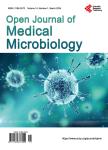Risk Factors and Prevalence of Mother to New-Born Transmission of Carbapenemase Producing Enterobacteriaceae in Two Hospitals in Yaounde, Cameroon
Risk Factors and Prevalence of Mother to New-Born Transmission of Carbapenemase Producing Enterobacteriaceae in Two Hospitals in Yaounde, Cameroon作者机构:Microbiology Department Faculty of Health Sciences Université des Montagnes Bangangté Cameroon American Society of Microbiology Bangangté Cameroon Department of Microbiology and Parasitology Faculty of Sciences University of Buea Buea Cameroon Bacteriology Laboratory Yaounde Gynaeco-Obstetric and Pediatric Hospital Yaounde Cameroon Department of Medical Laboratory Science Faculty of Health Sciences University of Buea Buea Cameroon
出 版 物:《Open Journal of Medical Microbiology》 (医学微生物学(英文))
年 卷 期:2023年第13卷第1期
页 面:116-124页
学科分类:081702[工学-化学工艺] 07[理学] 08[工学] 0817[工学-化学工程与技术] 070305[理学-高分子化学与物理] 0703[理学-化学]
主 题:Drug Resistance Carbapenems Pregnant Women Vertical Transmission Cameroon
摘 要:Background: In African countries, where the burden of neonatal sepsis is the highest, the spread of Carbapenemases Producing Enterobacteriaceae (CPE) in the community, potentially contributing to neonatal mortality, is a public health concern. The transmission routes are not well defined, particularly the possible key role played by pregnant women. The aim of this study was to understand the neonatal acquisition of CPE in Yaounde, Cameroon. Methods: A transversal analytical study was conducted in an urban area. Maternal stool samples during delivery and the first stool from their new-born were collected and cultured to isolate Enterobacteria. After isolation, characterization using API20E identification system, and antibiotic susceptibility testing were performed according to the Antibiogram Committee of the French Society of Microbiology. Carbapenemases detection was done on each carbapenem-resistant strain using the Modified Hodge Test (MHT) and their classification using the synergy tests with different inhibitors. Results: Out of the 55 CPE isolates identified, Escherichia coli was the most encountered bacteria both in mothers (n = 18, 50.00%) and infants (n = 11, 57.89%). Class B and D carbapenemases were found both in mothers and infants. The estimated prevalence of vertical transmission in our study, was 10% (n = 12). Logistic regression showed that CPE carriage in mothers and CPE acquisition in their new-borns were independently associated with the presence of greenish amniotic fluid (OR = 7.33, p 0.0001 in mothers and OR = 4.09, p = 0.0086 in new-borns). Conclusion: Our results highlight the non-negligeable role played by pregnant women in the neonatal acquisition of CPE.



